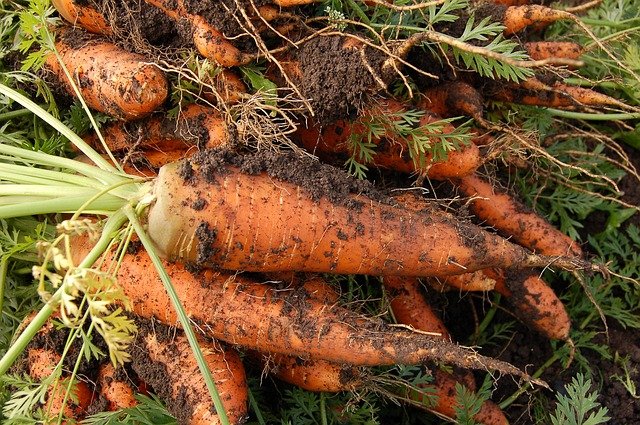Carrot (D. carota L. sub so. sativus (Hoffm.) Thell.) is derived from the wide carrot (D. carota L. sub sp. carota) which occurs naturally in Europe, Asia and Africa.
It is of ancient cultivation in the Mediterranean region and has now spread throughout the tropical world.
The Ecology of the vegetable
Soils which are well drained with a reasonable sand content and good reserves of organic material and essential elements are generally suitable.
Poorly drained soils are likely to encourage the spread of bacterial diseases and heavy clay soils are also likely to encourage the production of twisted, malformed roots of poot quality.
Optimum soil pH is in the region of 6.0-6.5.
The crop is fairly sensitive to temperature and the optimum air temperature for it being 15-25°C.
High soil temperatures may affect germination, encourage the production of short roots, formation of pale yellow roots, fibrous root tissues and reduction of beta carotene content.
Carrots are tolerant of a wide range of rainfall but excessive rainfall may cause a reduction in root color.
Dry soil conditions are likely to cause cracking of the roots and tend to favor the development of long roots.
Altitudes of more than 500m are necessary for economic yields. Short day lengths may contribute to a reduction in the beta carotene content of the roots.
Carrot Botany
An erect biennial, normally grown as an annual, 30-100cm in height. The leaves, which are dark green arise from the base of the plant.
They form a whorl of long-petioled, pinnately compound leaves.
The stem is solid, condensed at the proximal part of the root. The main or taproot becomes swollen and thickened and varies in shape and size, normally orange or red in color. This is the part that is consumed.
A cross section of the root reveals two distinct zones: the outer zone is composed of a thin periderm and a relatively wide band of cortex and secondary phloem where sugars and carotene are mainly stored.
The inner central core is somewhat woody and unpalatable, consisting of secondary of secondary xylem and the pith.
Flowers and seeds may be formed in the second year of growth. Flowers are normally white or pink.
The fruit is oblong to avoid in shape and the seeds contain an essential oil.
Seeds are rarely formed in tropical conditions since mean day temperatures of less than 20°C are required.
Cultivars
Cultivars are mainly of temperature origin. Some of the cultivars grown in west Africa include ‘Early Nantes’, ‘Early Scarlet horn’, ‘Nantes Improved’, and ‘Chantenay Elite’.
Cultural practices of carrot
Propagation is by seeds only and seed requirement is approximately 5-6kg/ha.
The seeds are sown either in raised seedbeds or ridges at a depth of 1-2cm in drills, 30-40cm apart.
Seedlings are thinned when 5-8c tall to 5-10cm apart depending on the vigour of the cultivars.
Planting can be done on the flat in well loosened soil. The crop is sown when the rains are established but dry season carrots are sown in November.
Watering on regular basis is necessary. In very hot weather, light shading may be required.
The plant is a heavy feeder, especially of potash. Dressings of nitrogen are also beneficial.
Fertilizers can be applied at the rate of 50kg N, 38kg P¿2O¿5 and 60kg K¿2O per hectare.
Apply wood ash, phosphate and potash during seedbed preparation and incorporate thoroughly.
Nitrogen is applied in two doses, at 2 and 6 weeks after planting.
Harvesting Carrot vegetable
Roots may be harvested 2.5 to 3 months after planting depending on the size required and the cultivar.
Irrigation before lifting may reduce may reduce damage to the roots.
Yield Expectations
Accurate yield data are not available but yields of 8-15t/ha may be obtained.
If seed is to be produced, roots of the optimum size, color and shape should be selected for seeding in their second year.
The dry seed heads are cut and threshed. Average seed yield is about 200- 300kg/ha.
How to Store Carrots
Carrots can be stored for several months without loss in quality. Storage life is dependent on the presence or absence of leaves and the stage of maturity of the roots at harvest.
Bunched, immature carrots with leaves, will store for about 21 days, with a weight loss of 15% but topped mature roots may remain in good condition for 100-150 days or longer at temperatures near 0°C.
At temperatures of 10°C or above, roots are likely to show significant damage from pathogens and temperatures of 5°C are therefore recommended with a relative humidity of 95-100%.
Sprouting is likely to occur at higher temperatures. Temperatures near 0°C will reduce not only sprouting but also the development of a bitter flavor, ethylene production and pathogenic activity.
Uses of Carrot
Carrots are used in a variety of ways:
- They may be eaten raw or cooked as a vegetable or used for flavoring soups, stews, curries or other dishes.
- The large-sized roots are used in salad or sometimes the juice is extracted and used as a drink.
- Carrots are also canned or dehydrated.
- Carrots are rich in carotene and carotene concentrates are prepared from them for coloring butter and other foods.
- The tender roots are pickled or made into jams.
- Its seeds are aromatic and are used as a stimulant. They contain essential oil, which is used for flavoring and in perfumery.
- The roots and tops are also used for fodder for cattle and horses.
Pest and diseases of Carrot
Common diseases include leaf spot by Alternaria dauci and Cercospora carotae.
Root knot nematodes (Meloidogyne spp.) are common pests, especially if crop rotation is not practised.








